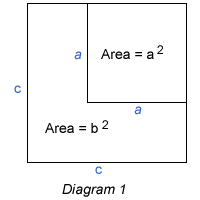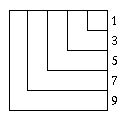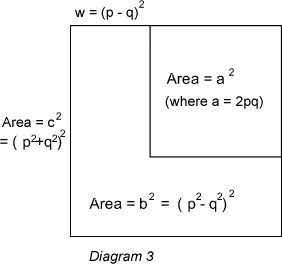Copyright © University of Cambridge. All rights reserved.
'Picturing Pythagorean Triples' printed from https://nrich.maths.org/
Show menu
Somewhat surprisingly every Pythagorean triple $( a, b, c)$,
where $a, b$ and $c$ are positive integers and $a^2+b^2 = c^2$, can
be illustrated by this diagram, in which the L shaped region has
area $b^2$, and the areas of the larger and smaller squares are
$c^2$ and $a^2$.
With this clue you can find some triples for yourself right
away. With an L strip of width 1 unit you get the whole class of
Pythagorean triples with $a$ and $c$ as consecutive integers, that
is $c = a+1.$
|
 |
 Diagram 2
|
This diagram (extended as far as required)
illustrates the fact that, for all $n$, the sum of the first $n$
odd numbers gives $n^2$. As we can see from the diagram to the
left:
\begin{eqnarray}1+3&=&2^2&=&4 \\ 1+3+5 &=&
3^2 &=& 9 \\ 1+3 +5 + 7 &=& 4^2 &=& 16 \\
1+3+5+7+9 &=& 5^2 &=& 25 \end{eqnarray}
|
Taking $a= 4$ and $c= 5$, the area of the outer ``L'' strip is
$b^2= 9$ and this gives the first Pythagorean triple $4^2+ 3^2=
5^2$.
Before reading on, can you use more strips of unit width and
extend the diagram to find Pythagorean triples with $b^2 = 25, 49,
81, 121$ etc.?
For every odd square number $b^2$, we can pick out a
Pythagorean triple.
As the Diagram 2 shows, $c = a + 1$ and hence \begin{eqnarray}
b^2 = c^2 - a^2 \\ b^2 = (a+1)^2 - a^2 \\ b^2 = a^2 + 2a +1 -a^2\\
= 2a + 1 \end{eqnarray} The next odd square after $3^2 = 9$ is $5^2
= 25$
Let $$25 = b^2$$
$$25 = 2*12 + 1$$
giving $a$ = 12 and from there the triple
$5^2+12^2=13^2$
The next one in this class is $b=7$ giving $a=24 =
\frac{(49-1)}{2}$ and $c=25$
Giving the triple $24^2+7^2=25^2$, and so on.
This method gives us infinitely many Pythagorean triples, but
what about others where the width of the L strip (the difference
between $a$ and $c$) is more than 1?
 |
To find other triples with L strips of different widths try
this for yourself:
For example, taking $p= 5$ and $q= 2$, the inner square has
dimensions $20$ by $20$ and the outer square has dimensions $29$ by
$29$, the width of the L strip is $9$, and the area of the L strip
is $(25-4)^2=21^2$, giving the Pythagorean triple $(20, 21,
29)$.
|
The process given by these instructions produces what is
called a parameterisation and $p$ and $q$ are called parameters. It
is easy to show by simple algebra that, by choosing positive
integers $p$ and $q$, with $p> q$, and taking
$$b = p^2-q^2$$
$$a = 2p q$$
$$c = p^2 + q^2$$
we get a Pythagorean triple.
This does not give all triples, for example it does not give
($9,12,15)$, but it does give all triples for which $a, b$ and $c$
have no common factor (`primitive' triples). Every other triple can
then be found by calculating $( k a, k b, k c)$ for some integer
$k$.
These results are proved in the article Pythagorean
Triples II .
We shall concentrate on finding all the triples where $a, b$ and $c$ have no common factor. If $p$ and $q$ have a common factor, or if $p$ and $q$ are both odd, then $a, b$ and $c$ will have a common factor.
We only need the cases where one of $p$ and $q$ is even and the other is odd. In such cases the width of the L strip $= c-a=(p-q)^2$ is always an odd square.
The table below (extended in the obvious way) shows all the `primitive' Pythagorean triples, and some non-primitive triples as well.
| Pythagorean Triples | $c-b=1^2$ ($p=q+1$) |
$c-b=3^2$ ($p=q+3$) |
$c-b=5^2$ ($p=q+5$) |
$c-b=7^2$ ($p=q+7$) |
$c-b=9^2$ ($p=q+9$) |
|---|---|---|---|---|---|
|
$c-a=2 \times 1^2$
$(q=1)$
|
3, 4, 5 | 15, 8, 17 | 35, 12, 37 | 63, 16, 65 |
99, 20, 101
|
|
$c-a=2 \times 2^2$
$(q=2)$
|
5, 12, 13 | 21, 20, 29 | 45, 28, 53 | 77, 36, 85 | 117, 44, 125 |
|
$c-a=2 \times 3^2$
$ (q=3)$
|
7, 24, 25 | 27, 36, 45 | 55, 48, 73 | 91, 60, 109 | 135, 72, 153 |
|
$c-a=2 \times 4^2$
$(q=4)$
|
9, 40, 41 | 33, 56, 65 | 65, 72, 97 | 105, 88, 137 | 153, 104, 185 |
|
$c-a=2 \times 5^2$
$(q=5)$
|
11, 60, 61 | 39, 80, 89 | 75, 100, 125 | 119, 120, 169 | 171, 140, 221 |
|
$c-a=2 \times 6^2$
$(q=6)$
|
13, 84, 85 | 45, 108, 117 | 85, 132, 157 | 133, 156, 205 | 189, 180, 261 |
|
$c-a=2 \times 7^2$
$ (q=7)$
|
15, 112, 113 | 51, 140, 149 | 95, 168, 193 | 147, 196, 245 | 207, 224, 305 |
|
$c-a=2 \times 8^2$
$(q=8)$
|
17, 144, 145 | 57, 176, 185 | 105, 208, 233 | 161, 240, 289 | 225, 272, 353 |
|
$c-a=2 \times 9^2$
$(q=9)$
|
19, 180, 181 | 63, 216, 225 | 115, 252, 277 | 175, 288, 337 | 243, 324, 405 |
There is a dual illustration of each triple where the smaller square has side $p^2 - q^2$ and the width of the L strip is $2q^2$. In the dual case for $p=5$ and $q =2$ the inner square has dimensions $21$ by $21$ and the width of the L strip is $8$ units giving the triple $(20,21,29)$.
Given a Pythagorean triple $(a, b, c)$ you can always `work back' to find $p$ and $q$, and given $p$ and $q$ you can always calculate $a, b$ and $c$. You could compete with a friend, both choose a value for $p$ and $q$ and compute a Pythagorean triple $(a, b, c)$ which you give to the other person. Then without using calculators, see who can be the first to find the values of $p$ and $q$. You may need to keep $p$ and $q$ small at first to make this easy for yourselves but as you get better you can take bigger values of $p$ and $q$.